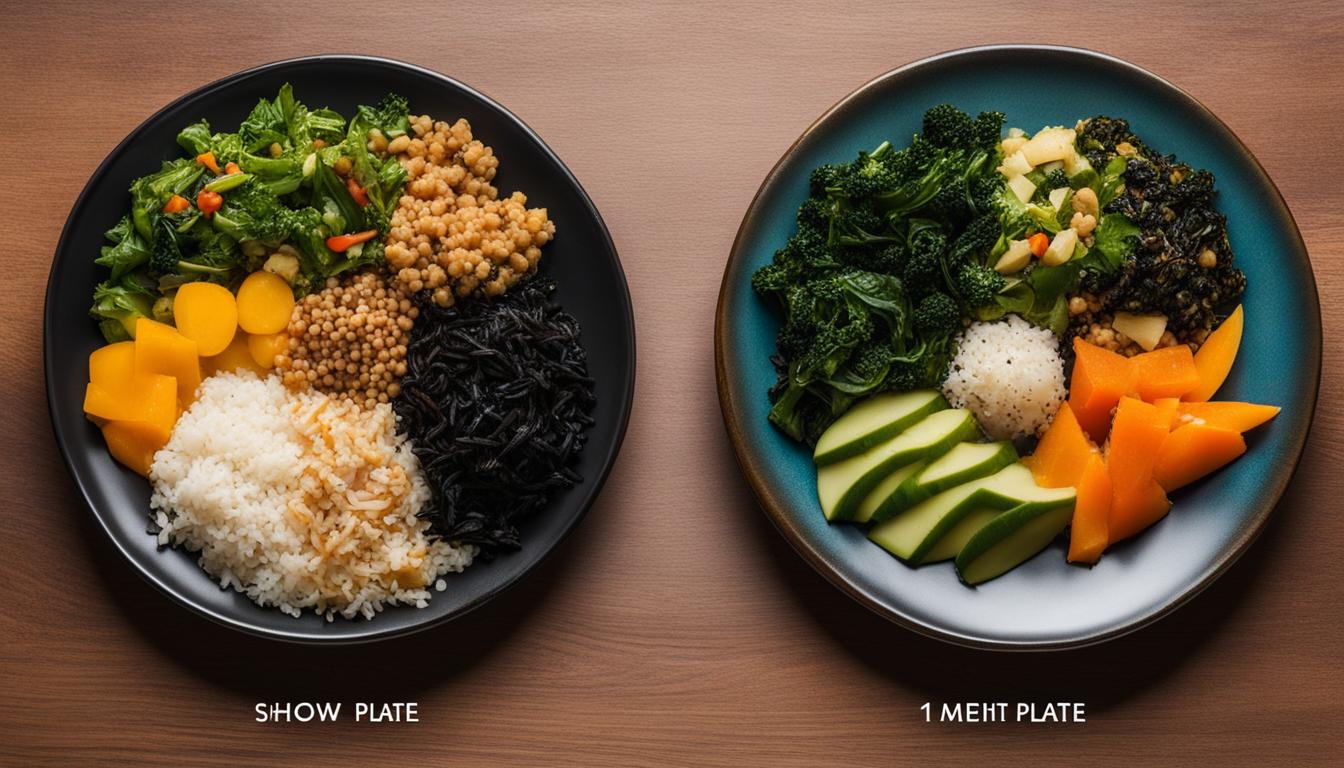Intermittent fasting and time-restricted eating are two popular approaches to achieving a variety of health goals, including weight loss, improved metabolism, and longevity. While both methods involve periods of fasting, they differ in the duration and frequency of these periods, as well as the specific eating patterns that are recommended.
Intermittent fasting involves alternating periods of food intake and fasting, with some methods recommending up to 24 hours of fasting at a time. On the other hand, time-restricted eating involves limiting the daily window of time during which food is consumed, with most plans suggesting an 8-10 hour eating window per day.
Both approaches have their unique benefits and drawbacks, and it’s important for individuals to understand the differences in order to choose the method that best aligns with their personal goals and lifestyle.
Key Takeaways:
- Intermittent fasting and time-restricted eating are two popular approaches to achieving health goals.
- Intermittent fasting involves alternating periods of food intake and fasting, while time-restricted eating limits the daily window of time for food consumption.
- Both approaches offer unique benefits, and individuals should choose the method that aligns with their personal goals and lifestyle.
What is Intermittent Fasting?
If you’re looking to lose weight or improve your health, intermittent fasting may be worth exploring. This approach involves cycling between periods of eating and fasting, with the aim of restricting calorie intake while still providing essential nutrients to the body.
Intermittent fasting can take on various forms, such as:
- The 16/8 method: This involves limiting eating to an 8-hour window each day and fasting for the remaining 16 hours.
- The 5:2 method: This involves consuming a normal amount of food for five days of the week and reducing calorie intake to about 25% of normal intake for the remaining two days.
- The Eat-Stop-Eat Method: This involves fasting for 24 hours once or twice a week.
Intermittent fasting has been shown to promote weight loss by reducing calorie intake and boosting metabolism through increased fat burning. Additionally, it can improve insulin sensitivity, which is beneficial for those with diabetes or at risk of developing it.
During fasting periods, the body can also focus on repairing and detoxifying itself, leading to potential longevity benefits. However, it is important to note that intermittent fasting is not suitable for everyone, especially those with a history of disordered eating or those who are pregnant or breastfeeding.
What is Time-Restricted Eating?
Time-restricted eating is a type of fasting that involves restricting the time period during which one consumes calories. This approach emphasizes eating during a specific window of time – typically between 6-8 hours per day – while abstaining from food consumption during the remaining hours.
Time-restricted eating has gained popularity in recent years due to its potential health benefits. By allowing the body to enter a fasted state for a longer period, it may help regulate hormones related to hunger and metabolism, leading to weight loss and improved overall health. Additionally, time-restricted eating may improve digestion, offer better sleep quality and may support a healthy lifestyle.
During the eating window, individuals should aim to consume nutrient-dense, whole foods to support their health goals. Outside of the eating window, beverages such as water, tea, and coffee can be consumed without breaking the fast.
Some research suggests that time-restricted eating may be more beneficial in the morning, or earlier in the day. The idea is that by consuming calories earlier in the day, the body has more time to process and digest the food, leading to better sleep quality and improved metabolic health.
While time-restricted eating is not a diet plan, it is a sustainable approach to maintaining a healthy lifestyle. It may help individuals develop better relationships with food, regulate their appetite, and support their overall well-being.
Benefits of Intermittent Fasting
Intermittent fasting has been shown to have numerous benefits for overall health and wellness. Here are some of the most significant potential benefits:
| Benefit | Description |
|---|---|
| Improved insulin sensitivity | Intermittent fasting has been linked to improved insulin levels, potentially lowering the risk of developing type 2 diabetes. |
| Enhanced fat burning | During periods of fasting, the body uses stored fat as a source of energy which can lead to greater fat burning and potential weight loss. |
| Possible longevity effects | Some studies suggest that intermittent fasting may increase lifespan and improve cellular function and repair. |
Overall, intermittent fasting has the potential to improve metabolic health, promote weight loss, and increase longevity.
Benefits of Time-Restricted Eating
Time-restricted eating, or TRE, has gained popularity among health enthusiasts due to its promising benefits. Here are some of the potential advantages of incorporating TRE into your lifestyle:
- Better digestion: By limiting the time when you consume food, your digestive system has the opportunity to rest and improve its function, potentially reducing symptoms such as bloating, gas, and indigestion.
- Improved sleep quality: Some studies suggest that TRE may help regulate circadian rhythms, leading to better sleep quality and a more refreshed feeling in the morning.
- Weight management: By restricting the window of time in which you consume food, you may naturally consume fewer calories, which can lead to weight loss and improved body composition.
While more research is needed to fully understand the benefits of TRE, these potential advantages make it a worthwhile approach to consider for a healthy lifestyle.
Intermittent Fasting vs Time-Restricted Eating
Both intermittent fasting and time-restricted eating involve periods of food restriction, but they differ in the duration and flexibility of the fasting window. Intermittent fasting typically involves longer periods of fasting, ranging from 16 to 24 hours, followed by a shorter feeding window. Time-restricted eating, on the other hand, limits the feeding window to a specific period of time each day, usually ranging from 6 to 10 hours.
Intermittent fasting may be more suitable for those seeking more significant weight loss or metabolic benefits, as longer fasting periods have been shown to increase insulin sensitivity, promote fat burning, and potentially extend lifespan. However, it can be more challenging to maintain a longer fasting window for some individuals.
Time-restricted eating may be a more sustainable approach for those seeking to adopt a healthy lifestyle, as it allows for more flexibility in terms of eating times and durations. It has been associated with improved digestion, better sleep quality, and potential weight management benefits. However, the shorter fasting period may not yield the same metabolic benefits as intermittent fasting.
Ultimately, the choice between intermittent fasting and time-restricted eating depends on individual preferences and goals. Consulting with a healthcare professional can help determine which approach is best suited for a person’s needs. It is also important to note that both approaches should be combined with a healthy diet and exercise for optimal health.
Conclusion
In conclusion, both intermittent fasting and time-restricted eating offer potential benefits for individuals seeking to improve their overall health and well-being. However, it’s essential to choose an approach that aligns with personal preferences and lifestyle goals. It’s also important to consult with a healthcare professional before starting any fasting regimen to ensure safety and proper guidance.
Intermittent fasting has been linked to improved insulin sensitivity, enhanced fat burning, and potential longevity effects, making it an effective weight loss approach for many. On the other hand, time-restricted eating can offer benefits such as improved digestion, better sleep quality, and potential weight management benefits, making it a sustainable approach to maintaining a healthy lifestyle.
While both approaches share some similarities, such as limiting food intake to specific periods, they have key differences in terms of fasting duration, eating patterns, and overall flexibility. Hence, choosing the best one depends on personal preferences, lifestyle goals, and individual health needs.
To conclude, incorporating either intermittent fasting or time-restricted eating into a healthy lifestyle can lead to significant improvements in overall health. Therefore, it’s essential to explore both options and determine what works best for each individual’s unique needs and preferences.
FAQ
Q: What is the difference between intermittent fasting and time-restricted eating?
A: Intermittent fasting involves alternating periods of fasting and eating, while time-restricted eating restricts eating to a specific window of time each day.
Q: How does intermittent fasting work?
A: Intermittent fasting works by allowing the body to enter a state of fasting, which can promote fat burning, improve insulin sensitivity, and potentially have longevity effects.
Q: What is time-restricted eating?
A: Time-restricted eating involves limiting eating to a specific window of time each day, typically around 8-12 hours, and fasting for the remaining hours.
Q: What are the benefits of intermittent fasting?
A: Intermittent fasting can improve insulin sensitivity, enhance fat burning, and potentially have longevity effects on overall health.
Q: What are the benefits of time-restricted eating?
A: Time-restricted eating can improve digestion, promote better sleep quality, and potentially aid in weight management.
Q: How do intermittent fasting and time-restricted eating compare?
A: Intermittent fasting and time-restricted eating have similarities in terms of fasting duration and promoting health benefits. However, they differ in terms of eating patterns and overall flexibility.
 Skip to main content
Skip to main content


